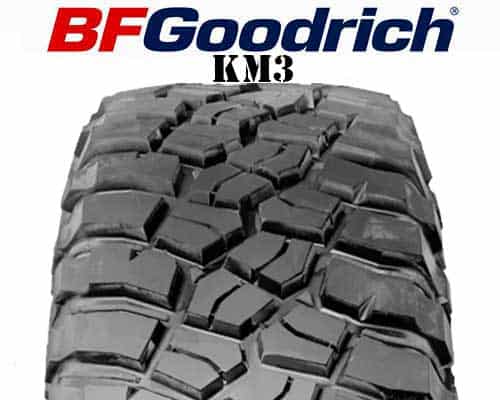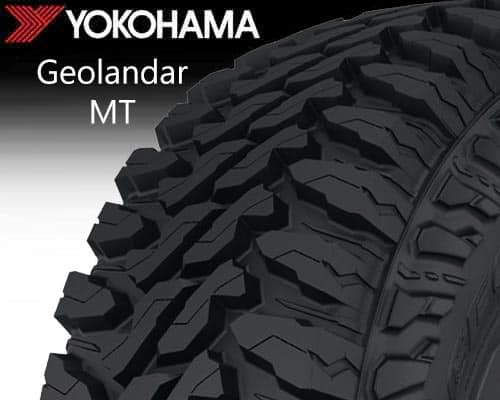Yokohama Geolandar and BF Goodrich KM3 both are mud-terrain tires, having higher void ratios and wide grooves. However, Geolandar offers a higher void ratio comparatively and results in a lower performance on-road tire, contradict to that, shows superior skills off-road due to its wider grooves.
On the other hand, KM3 due to narrow grooves lacks off-road traction but performs well on-road. To have a detailed analysis and comparison between these tires, read till the end.

Table of Contents
Comparing BFG KM3 with Yokohama Geolandar MT
Yokohama Geolandar M/T

BF Goodrich KM3


Vs

Yokohama Geolandar M/T features an innovative and aggressive tread design with a higher void ratio and minimum contact patch with the surface.
Therefore, the tire grip is lowered, providing poor on-road dry traction. However, the wide grooves and deep sipes of this tire are proven effective in wiping away water and give excellent grip on wet roads. Thus, giving the best performance on wet roads.
The wide grooves and open shoulder design of Geolandar grant it excellent traction in mud.
The wide grooves are also effective for movement on soft snow, but they reduce the contact patch and tire grip, so this tire struggles on ice. Bold stone ejectors of this tire prevent small stones/pebbles from getting stuck into the tire tread and wide grooves aids in giving excellent grip to the tire on rocks.
Shoulder lugs protect the sidewall and an aggressive armor on the sidewall guards the tire against side damage, granting it an overall strong built. The tread pattern of this tire is computerized to minimize the noise, yet it is noisier compared to its counterpart but, provides enhanced comfort off-road by absorbing shocks.
KM3 also offers an aggressive symmetric tread design with a high void ratio but lesser compared to other tire, minimizing its contact patch.

A lower contact patch lowers the tire grip, so this tire performs poor on-road dry traction but not as poor as Yokohama Geolandar M/T. In wet conditions, the narrow grooves and deep sipes function in wiping away water and giving maximum grip, putting it second to its competitor due to relatively narrower grooves. The narrow grooves and open shoulder design give a decent performance in mud and soft snow but lack to its competitor because of its narrower grooves. However, the same narrow grooves increase the tire grip on icy roads making it a good choice in such conditions.

Its stone ejectors are bold but not like that of Geolandar, which hinders their ability to stop small stones/pebbles from getting stuck into the tire tread. The aggressive sidewall and specialized rim protectors give this tire a strong enough build to survive on rocky terrain.
On-Road Traction Comparison
Yokohama Geolandar M/T having higher void ratio results in having wide grooves which lower the contact patch of the tire, thus, increasing its braking distance on-road. Therefore, this tire is not efficient in on-road dry traction. However, wide grooves and full-depth sipes give this tire an edge to give a sensational performance in wet traction as they are effective in wiping away water with quite ease. As Geolandar has comparatively wider grooves than that of its competitor, so it is much better in wet traction.
KM3 also offers a decent void ratio and somewhat wide grooves which lowers its contact patch, thus, reducing the tire grip but it performs slightly better than its counterpart due to a relatively lower void ratio. However, the narrow grooves allow lower performance on wet traction as they can’t wipe away water efficiently.
Off-Road Traction Comparison
Mud Terrain
The wider grooves of Yokohama Geolandar M/T aids it to roll easily in mud as they provide several biting edges which bites the mud and efficiently throws it backward, allowing the tire to move boldly. The open shoulder design of this tire also helps in providing excellent traction in mud terrain by passing the mud easily through its wide shoulder grooves.

KM3 features narrow grooves, granting lower traction in mud comparatively. The slightly narrow grooves of this tire can also grab the mud and throw it backward, resulting in the forward movement of the tire. Open shoulders contain deep biting edges to enhance the performance of this tire in mud. Since the grooves of KM3 are comparatively less wide than that of Yokohama Geolandar M/T, so, the latter performs better in mud.
Snow Terrain
Geolandar exhibits wider grooves which enhances its performance on soft snow as they can effectively grab the soft snow and then throw it backward, assisting the tire to move efficiently and increases its snow traction. Its grooves are wider compared to its competitor, therefore, Geolandar dominates in soft snow. However, the wide grooves reduce the contact patch, leading to loss of grip, making the tire more slippery on ice.

KM3 possesses narrow grooves which are not efficient in biting soft snow and throwing it backward, resulting in lower performance of the tire on soft snow. Narrow grooves increase the tire grip on icy roads hence, decreasing the chances of slipping. This makes the tire perform relatively better on ice.
Rock Terrain
Stone ejectors are responsible for preventing the stones/pebbles from getting stuck into the tire tread whereas wide grooves are efficient in providing maximum grip over the rocks. Geolandar features comparatively wider grooves and bolder stone ejectors than that of its competitor, so it is a preferable option on rocks. Moreover, the sidewall armor and aggressive tread give this tire a strong composition, making it resistant to damage offered by the sharp-edged rocks.
KM3 is also an excellent tire on rocks as it also features many effective stone ejectors o which hinders the stones/pebbles from getting stuck into the tire tread. The notched tread of kM3 extends down the sidewall to give maximum coverage against trail damages. This tire is also a good option on rocks but lags behind Geolandar in its performance because it has comparatively narrower grooves and smaller stone ejectors.
Which Tire is More Comfortable?
In the case of on-road comfort, Geolandar is not comfortable on paved paths. As it offers a higher void ratio and wide grooves. Since wide grooves trap more air into them and when the tire rotates the packed air rushes out, producing loud noise. However, the wide grooves are comparatively better in absorbing the shocks while moving off-road, making their ride smoother.
KM3, on the other hand, is better at on-road travel due to its narrow grooves which trap a lower amount of air particles, producing lesser noise. These narrow grooves are not preferable on unpaved paths due to their inability to absorb shocks as effectively as wider grooves. This results in a bumpy ride off-road, making the tires unreliable in such conditions.
Treadwear and Durability
Yokohama Geolandar M/T possesses wide grooves offering a lower contact patch with the road, thus, lowering the rolling resistance of the tire. This reduces its treadwear, increasing the durability of the tire. Moreover, a high-density rubber compound is used in this tire which offers a triple polymer mixture, increasing the tire life. Geo Shield construction offered by Yokohama gives this tire extra strength. Two steel belts and a total nylon cap protect the tire against sharp-edged rocks. Also, the tread design of this tire is comprehensive to give additional tread life.
KM3 has a lower void ratio, therefore, offers a lower contact patch and reduces the rolling resistance of the tire. This results in the reduction of the treadwear, thus, its durability increases. The unique tread design of this tire offers resistance against chips, cuts, and pinch shock. However, this tire is affiliated with CoreGard Max race-proven technology which helps to avoid splitting and puncturing of the tire. After all, the contact patch of KM3 is comparatively less than that of Geolandar, promoting more treadwear and less durability than that of the competitor.
Difference in Price
Both tires being mud-terrain do not have a noticeable difference in their price, but Geolandar is slightly expensive than KM3 because the former gives better off-road traction. Both have their plus points over each other but do not differ too much in their performance outputs.
Quick Summary
- Both are mud-terrain tires.
- In the case of on-road dry traction, KM3 performs better due to its comparatively lesser wide grooves
- In wet traction, Geolandar dominates as its grooves are comparatively wider than that of KM3.
- In mud traction, Geolandar is a better choice due to its wide grooves.
- On soft snow, Geolandar again shows the way to KM3 because it has wide grooves
- On the ice, KM3 performs a little better because its grooves are less wide.
- Geolandar has wide grooves and bold stone ejectors that lead on rocks.
- Both tires have good durability, but Geolandar has a stronger built is more durable.
- There is not a noticeable difference in their prices. However, Geolandar costs more.


